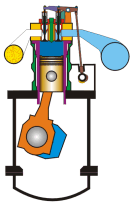|

|
The Basics
The 4 Stroke
Diesel Cycle
|
****JavaScript based drop down DHTML menu generated by NavStudio. (OpenCube Inc. - http://www.opencube.com)****
|
|
|
 |
Nickolaus Otto invented the 4 stroke cycle in 1862.
More details of how the four stroke spark ignition cycle works,
together with pictures of Otto's first engines can be found here |
|
 |
In 1892 Rudolph Diesel invented the compression
ignition engine, now named after him. The first working engine was
built at the Augsburg
Maschinenfabrik (now part of the MAN B&W group) in 1897. The single cylinder engine was used to
power stationary machinery. It weighed five tonnes and produced 20 hp at
172 rpm! The engine operated at 26.2% efficiency, a very significant
improvement on the 20% achieved by the best petrol engines of the time.
|
 |
In 1912 the first ocean
going vessel to have diesel engines installed was the Selandia. The
engines were 8 cylinder 4 strokes. An idea of their size can be got
from the man standing by the engine controls half way down the
engine. The four stroke cycle is so called because it takes four strokes of the
piston to complete the processes needed to convert the energy in the fuel
into work. Because the engine is reciprocating, this means that the piston
must move up and down the cylinder twice, and therefore the crankshaft
must revolve twice.
The four strokes of the piston are known as the induction stroke, the
compression stroke, the power stroke, and the exhaust stroke. Students
sometimes remember this as "suck, squeeze, bang, blow."
|

1. INDUCTION:
The crankshaft is rotating clockwise and the piston is moving down
the cylinder. The inlet valve is open and a fresh charge of air is
being drawn or pushed into the cylinder by the turbocharger |

2. COMPRESSION: The inlet valve has closed and the charge
of air is being compressed by the piston as it moves up the
cylinder. Because energy is being transferred into the air, its
pressure and temperature increase. By the time the piston is
approaching the top of the cylinder (known as Top Dead Centre or TDC)
the pressure is over 100 bar and the temperature over 500°C
|
|

3. POWER: Just before TDC fuel is injected into the
cylinder by the fuel injector. The fuel is "atomised"
into tiny droplets. Because they are very small these droplets heat
up very quickly and start to burn as the piston passes over TDC. The
expanding gas from the fuel burning in the oxygen forces the piston
down the cylinder, turning the crankshaft. It is during this stroke
that work energy is being put into the engine; during the other 3
strokes of the piston, the engine is having to do the work. |

4. EXHAUST: As the piston approaches the bottom of the
cylinder (known as Bottom Dead Centre or BDC) the exhaust valve
starts to open. As the piston now moves up the cylinder, the hot
gases (consisting mostly of nitrogen, carbon dioxide, water vapour
and unused oxygen) are expelled from the cylinder.
As the Piston approaches TDC again the inlet valve starts to open
and the cycle repeats itself. |




|










